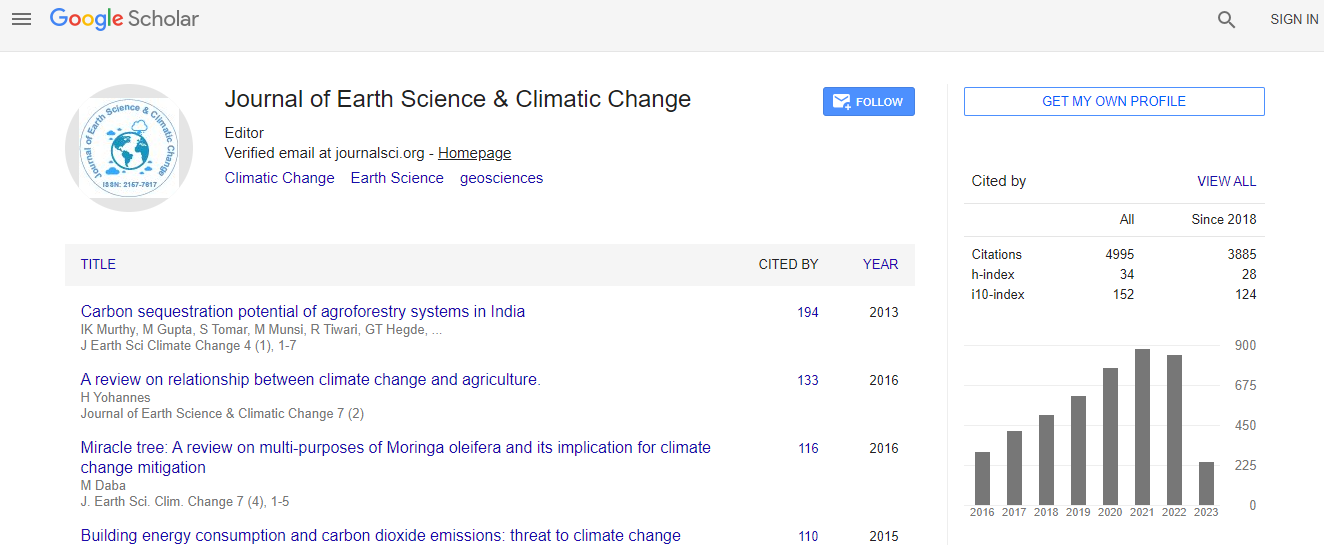Our Group organises 3000+ Global Conferenceseries Events every year across USA, Europe & Asia with support from 1000 more scientific Societies and Publishes 700+ Open Access Journals which contains over 50000 eminent personalities, reputed scientists as editorial board members.
Open Access Journals gaining more Readers and Citations
700 Journals and 15,000,000 Readers Each Journal is getting 25,000+ Readers
Google Scholar citation report
Citations : 5125
Journal of Earth Science & Climatic Change received 5125 citations as per Google Scholar report
Journal of Earth Science & Climatic Change peer review process verified at publons
Indexed In
- CAS Source Index (CASSI)
- Index Copernicus
- Google Scholar
- Sherpa Romeo
- Online Access to Research in the Environment (OARE)
- Open J Gate
- Genamics JournalSeek
- JournalTOCs
- Ulrich's Periodicals Directory
- Access to Global Online Research in Agriculture (AGORA)
- Centre for Agriculture and Biosciences International (CABI)
- RefSeek
- Hamdard University
- EBSCO A-Z
- OCLC- WorldCat
- Proquest Summons
- SWB online catalog
- Publons
- Euro Pub
- ICMJE
Useful Links
Recommended Journals
Related Subjects
Share This Page
In Association with

The critical effect of fossil fuels produced acidic gases (S (IV) and nitrogen oxides) on the resident time of CO2 in the atmosphere
5th International Conference on Earth Science & Climate Change
Mahmoud R Reda and G Reda
Canadelectrochim, Canada
Posters & Accepted Abstracts: J Earth Sci Clim Change
Abstract
There is a tremendous effort by various scientific groups to study the fate of carbon dioxides in the atmosphere. Two important methods for the removal of CO2 from the atmosphere are scavenging during rain events and photosynthesis by plants to oxygen and sugar. Here we show that atmospheric acidity due to sulfur (IV) and nitrogen oxides which are present in the range of few parts per million can lower the pH of the rain droplets and decrease the solubility of CO2 and thus scavenging rate. CO2 (gas)+H2O��?CO2(aq)��?HCO3 -1+H+. Although the amount of acidic gases in the atmosphere is only in the ppm range, the pH for small droplet can reach as low as 4. As more acidic the water becomes due to the presence of trace of S (IV) and nitrogen oxide, reaction 1 above will shift to the left and less CO2 will dissolve. Furthermore, it is well known that the first step during photosynthesis of CO2 to oxygen by plant leaves is the dissolution of gases CO2 into the moist surface of the plant leaves. The atmospheric acidity will lower the rate of the first step and thus acts as an inhibitor for the process of photosynthesis of CO2 to oxygen. A simple mathematical model based on the interaction of aqueous CO2 , S (IV) and NOx chemistry will be presented to support the above conclusion, namely that atmospheric acidity has a critical effects on the CO2 resident time in the atmosphere.Biography
Email: mreda14@gmail.com

 Spanish
Spanish  Chinese
Chinese  Russian
Russian  German
German  French
French  Japanese
Japanese  Portuguese
Portuguese  Hindi
Hindi 
